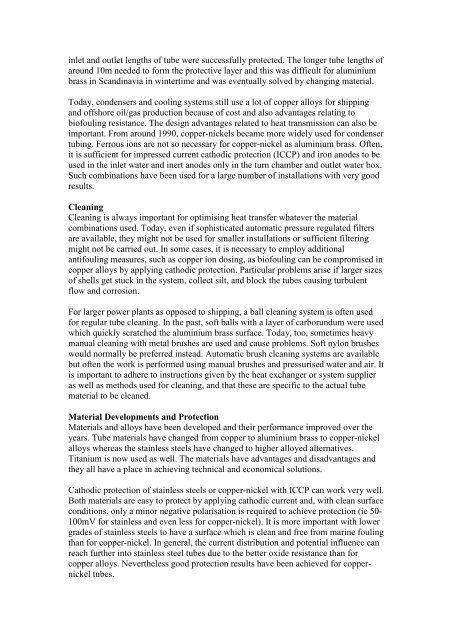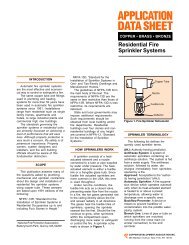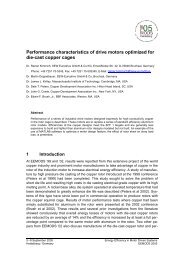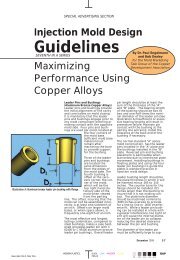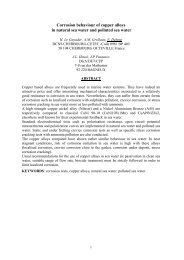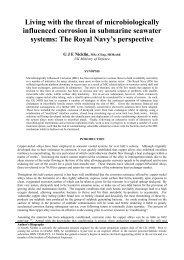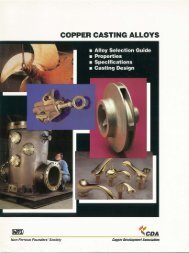Leif _rev3 - Copper Development Association
Leif _rev3 - Copper Development Association
Leif _rev3 - Copper Development Association
Create successful ePaper yourself
Turn your PDF publications into a flip-book with our unique Google optimized e-Paper software.
inlet and outlet lengths of tube were successfully protected. The longer tube lengths ofaround 10m needed to form the protective layer and this was difficult for aluminiumbrass in Scandinavia in wintertime and was eventually solved by changing material.Today, condensers and cooling systems still use a lot of copper alloys for shippingand offshore oil/gas production because of cost and also advantages relating tobiofouling resistance. The design advantages related to heat transmission can also beimportant. From around 1990, copper-nickels became more widely used for condensertubing. Ferrous ions are not so necessary for copper-nickel as aluminium brass. Often,it is sufficient for impressed current cathodic protection (ICCP) and iron anodes to beused in the inlet water and inert anodes only in the turn chamber and outlet water box.Such combinations have been used for a large number of installations with very goodresults.CleaningCleaning is always important for optimising heat transfer whatever the materialcombinations used. Today, even if sophisticated automatic pressure regulated filtersare available, they might not be used for smaller installations or sufficient filteringmight not be carried out. In some cases, it is necessary to employ additionalantifouling measures, such as copper ion dosing, as biofouling can be compromised incopper alloys by applying cathodic protection. Particular problems arise if larger sizesof shells get stuck in the system, collect silt, and block the tubes causing turbulentflow and corrosion.For larger power plants as opposed to shipping, a ball cleaning system is often usedfor regular tube cleaning. In the past, soft balls with a layer of carborundum were usedwhich quickly scratched the aluminium brass surface. Today, too, sometimes heavymanual cleaning with metal brushes are used and cause problems. Soft nylon brusheswould normally be preferred instead. Automatic brush cleaning systems are availablebut often the work is performed using manual brushes and pressurised water and air. Itis important to adhere to instructions given by the heat exchanger or system supplieras well as methods used for cleaning, and that these are specific to the actual tubematerial to be cleaned.Material <strong>Development</strong>s and ProtectionMaterials and alloys have been developed and their performance improved over theyears. Tube materials have changed from copper to aluminium brass to copper-nickelalloys whereas the stainless steels have changed to higher alloyed alternatives.Titanium is now used as well. The materials have advantages and disadvantages andthey all have a place in achieving technical and economical solutions.Cathodic protection of stainless steels or copper-nickel with ICCP can work very well.Both materials are easy to protect by applying cathodic current and, with clean surfaceconditions, only a minor negative polarisation is required to achieve protection (ie 50-100mV for stainless and even less for copper-nickel). It is more important with lowergrades of stainless steels to have a surface which is clean and free from marine foulingthan for copper-nickel. In general, the current distribution and potential influence canreach further into stainless steel tubes due to the better oxide resistance than forcopper alloys. Nevertheless good protection results have been achieved for coppernickeltubes.


